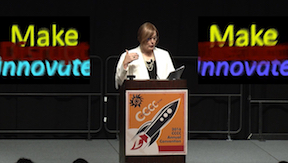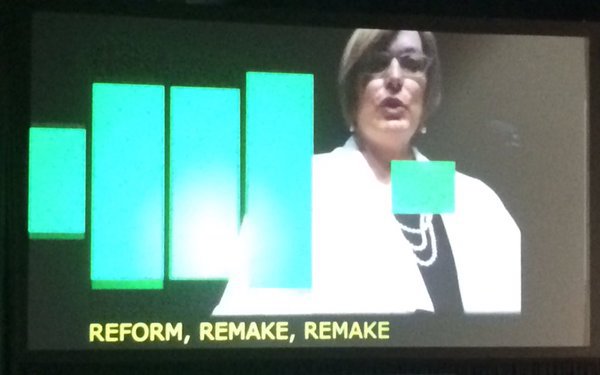
The final remediated video of "Making, Disrupting, Innovating"
Since 1977, when Richard Lloyd-Jones delivered the first Conference on College Composition and Communication (CCCC) Chair's Address, these addresses have regularly been printed in the conference's flagship journal, College Composition and Communication (CCC) (see Roen, 2006). With a few exceptions, Chairs' Addresses have been remediated as traditional print essays. That is, the printed versions of most addresses make no attempt to capture the mediated experience of watching and hearing the performance. Even when Cynthia L. Selfe disrupted audience members' expectations of a traditional talk by displaying images on overhead transparencies during her 1998 address, the printed 1999 version included no images and little trace of its genesis in a spoken address to a live audience. Thus, Selfe's visuals are virtually lost to the field’s memory.
Five years later, Kathleen Blake Yancey (2004) delivered her address, choosing to project 84 slides on two different screens in what Duane Roen (2006) called a "stunning performance" (p. 28). As she explained in a sidebar to the print version of the address, "While I talked, two synchronized PowerPoint slide shows ran independently, one to my right, another to my left.… As Chris Farris pointed out to me later, given this setting, the talk was more dramatic performance than address" (Yancey, 2004, p. 298). Yancey explained that she "designed a multi-genred and mediated text that would embody and illustrate the claims of the talk" (p. 299). The print version of the talk included a selection of those slides, "arranged anew," as well as a few images not in the original address in San Antonio (p. 300). In sidebars of the printed essay, Yancey asked readers questions like, "how many compositions are in this text?" (p. 300) and "how does this text—with call outs, palimpsest notes, and images—cohere?" (p. 301). In doing so, she called attention to the materiality and remediated nature of her print essay. Yancey's printed address may be the first (and perhaps the only, until Carter, 2016a) printed Chair’s Address to constitute Anne Frances Wysocki's (2004) conception of new media as media that call attention to their own materiality and construction.
But even though Yancey (2004) created a multigenre and multimodal print version of her address, Roen (2006) reflected, "For those who witnessed the performance in March 2004 and then read the printed version in December of that same year, the limits of the print, especially black ink on white paper, are readily apparent" (p. 29). Indeed, Yancey's (2004) print address was "a new text," not a mere "small morphing of a text from one medium to another," as she noted in another sidebar (p. 315).
Of the eleven printed addresses in CCC since Yancey's (2004), only four have broken from the words-only approach of the traditional essay, reprinting images or alluding to other multimodal dimensions of the talk. Douglas Hesse (2005), Judith Wootten (2006), Malea Powell (2012), and Chris Anson (2013) all included images in the print versions of their talks. Notably, Powell's (2012) printed address reads somewhat like a script, including the stories that were read aloud during her live performance. But lost is the spatial and aural experience of hearing these stories spoken from a variety of bodies and locations in an auditorium. Of course, a print essay can never capture the exact experience of an oral delivery—nor should it necessarily try. The nature of remediation is that while some of the affordances of prior media are carried forward, others are necessarily left behind (Bolter & Grusin, 1999).
CCCC has also attempted to capture addresses through video recordings, but these video recordings generally have not been made available to the field. In one exception, Hesse's (2005) address was video recorded and the "multimedia version" (p. 355) was hosted on The CCC Online Archive; however, the video file is no longer available on the website. (Additionally, the video files that accompanied Jenn Fishman, Andrea Lunsford, Beth McGregor, and Mark Otuteye's 2005 article in the same issue of CCC are also no longer available on CCC Online. For a discussion about the sustainability of digital scholarship, see Douglas Eyman and Cheryl E. Ball's 2016 "History of a Broken Thing"). While other talks have been video recorded, the only publicly available video is of Adam Banks's (2015) address, available on the National Council of Teachers of English's (CCCC's parent organization) YouTube channel (NCTE, 2015).
These print and video versions serve as archives of the addresses, making them accessible to scholars and teachers who couldn't attend the conference or to those who wish to revisit their arguments. While they are available for scholars to reference and cite later, they also have drawbacks. Such archives can't capture the fully dynamic, multimodal nature of a live address that draws on moving and still images working in coordination with the talk. Indeed, scholarship on the Chairs' Addresses, such as analyses by Ellen Barton (1999) and Derek Mueller (2012), have studied them largely as traditional print, alphabetic texts. With the exception of Roen's (2006) introduction to his collection of Chairs' Addresses, which includes some reflection from previous chairs about their embodied experiences (particularly their nervousness) and some reflections from CCCC members about their experiences of some addresses, the materiality and mediated experiences of Chairs' Addresses have been largely ignored. This neglect of these addresses’ multimodality and materiality is likely due both to our field’s attachment to print and to the availability of a mostly print archive.

We had concerns about Joyce's address and how both the print version and a "talking head" video version would not capture the dynamic, playful, and innovative aspects of her talk. While certainly these print or video remediations could capture the words she spoke, they would lose some of the immediacy and hypermediation of her address (to draw on Bolter & Grusin, 1999). Of course, we had no intention of recreating the address faithfully to how it was experienced in Houston: Watching a YouTube video alone (or even with colleagues) in one's office or at home could not equate to the experience of being part of a large co-present audience in an auditorium. However, in this remediation, we hoped to approximate some of the mediational choices Joyce made during her address.